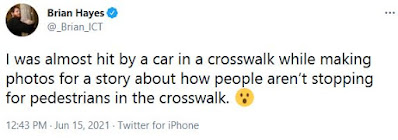On the one hand, it's great to see a piece on the front page today about our difficulties with crosswalks.
 |
| Churning a police press release |
On the other hand, the piece is framed up as "police share results," and generally represents only one point of view, that of the annual or monthly police press releases. It is not critical enough about investigating that perspective and looking at the total system problem.
Back in 2016-17 when the paper moved from their downtown building to suburban-style mid-rise office building on Commercial and Vista, I wondered how they would view Commercial Street car traffic and foot traffic. Just one lot south of their office building, at the Fussy Duck the east side of Commercial Street is missing a sidewalk to the intersection at Ratcliff. We have seen in a speed study that over 4000 drivers per day speed at more than 10mph over the posted speed limit right here on Commercial. The zoomy street seemed like a pretty good location for a close reading of traffic, safety, and comfort.
 |
| Crash into the Roth's parking lot |
Indeed, they have observed a pattern of crashes at the intersection. Earlier this month there was one, sending a car into the swale at Roth's. You wouldn't want to have been on foot and waiting to use the crosswalk or in the crosswalk at that moment!
In 2018 they saw others, with some of the photos clearly from the office building looking out over the intersection.
 |
| A sample of others from 2018 |
This past year, with reporters not in the office, there were fewer opportunities to see crashes.
 |
| So much speeding: The Police said "eye-opening" |
But the steady distribution of crashes right outside their windows has not seemed to have registered very strongly as anything other than background static and noise. It's significant only for the occasional story of injury and "snarled" traffic, centered on the frame of temporary congestion impact, but not for any reflection on our transportation system, its norms, especially a routine level of "minor" speeding, the way we receive traffic death and mayhem in culture.
 |
| This did not make it into the piece |
There was even an opportunity to link it to personal experience! Last week one of the photojournalists indicated they were working on a story "about how people aren't stopping for pedestrians in the crosswalk."
But the very same day last week, the paper fully erased the driver in an assault by car, making both in headline and in the lede the grammatical subject the car: "car hits protesters." But it is a driver who is responsible for the operation of a motor vehicle and who in this case almost certainly intended to strike and harm.
 |
| Erasing the driver |
The piece buries the fact that some politicians and legislators are trying to legalize vehicular assault.
And the personal hazard the photojournalist endured was not deemed significant enough to include in today's article.
Then again in today's paper with the crosswalk piece, there was another instance of erasing the driver.
 |
| Also erasing the driver |
This autoism is the general context for our problems with crosswalks, and if the paper wants to improve safety for people on foot, they should think through more deeply their autoist commitments and culture.
Just centering drivers and not erasing them in malignantly intentional acts and in careless acts is possible. The NY Times uses proper grammatical subjects and agents in discussing the Minneapolis assault.
 |
| You don't have to erase the driver |
The paper also got a new reporter on equity and social justice, and there is a emergent body of research on bias and disproportion in crosswalk observance and enforcement. White drivers don't yield to people of color, and people of color and homeless on foot are targeted by law enforcement disproportionately. Safe Routes to Schools has dropped "enforcement" from their philosophy, and aren't supporting these kinds of enforcement/education actions any more.
 |
| Research from 2017 at PSU |
But the paper didn't bring in that perspective here, either looking at how police enforce and apply law, or how our current environment might affect travel choice.
 |
| Race and travel choice - via Twitter |
In total what we get is continuing the idea people on foot are mainly responsible for their safety, and that people driving are rarely a problem. The system works, they seem to say.
But the problem is with our autoism and with people driving, not about improper walking behavior. Drivers can't even avoid a sign for a crosswalk right in front of a school!
 |
| People keep hitting stop sign on Market at Winter (end of January and the installation last July) |
 |
| Back in 2015 we said "troubling" but really, how troubled are we? |
For more on the cultural and legal context of our autoism in which we minimize the responsibility of drivers and shift blame to people on foot, see:
- "Why so much Acceptance for Traffic Cone Theory of Walking?" with discussion of a Salem Police PSA (2015)
- Notes on a City of Salem PSA, "City PSA on Time Change and Safety Needs Paradigm Change Itself." It has many links to the history of jaywalking also. (2019)
- On "distracted walking," "Death on Foot: Too Much on Distracted Walking Canard." (2018)
- "Why Pedestrian Rights themselves may not be Sufficient." (2015)
- Two discussions of a law review article about our system of subsidy for autoism, "The Laws for Compulsory Autoism at The Atlantic," and "Police Publish Video on How to Speed Without a Ticket." (both 2019)


No comments:
Post a Comment